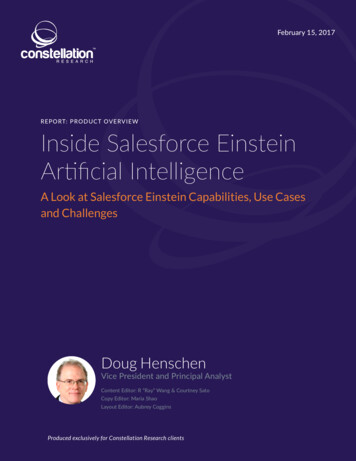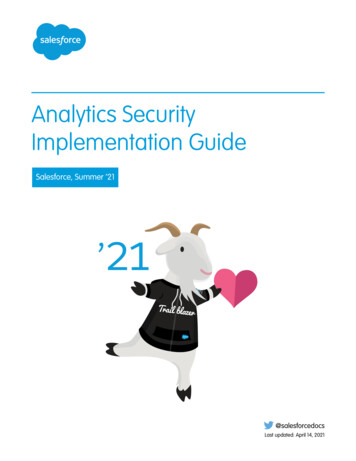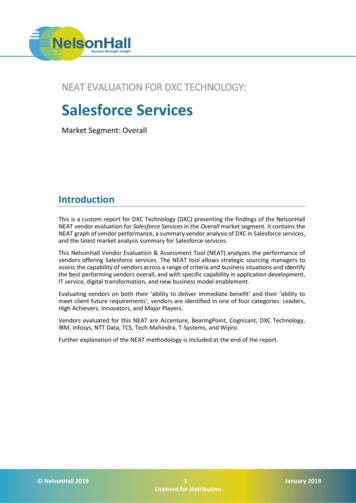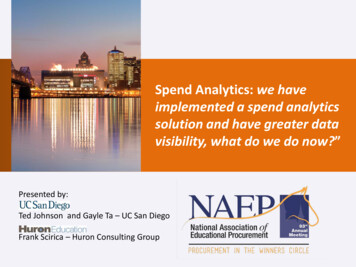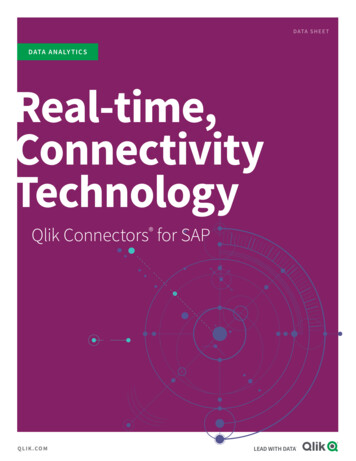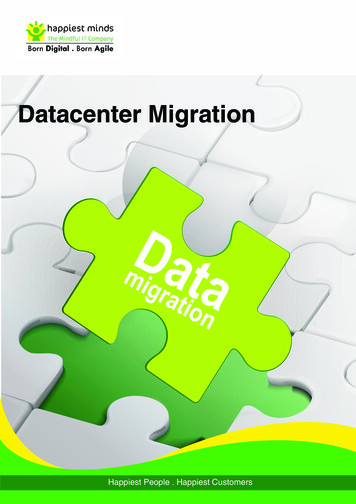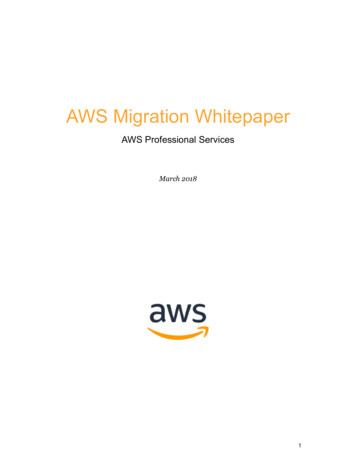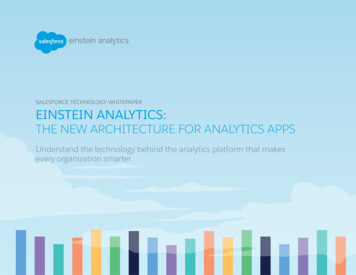
Transcription
SALESFORCE TECHNOLOGY WHITEPAPEREINSTEIN ANALYTICS:THE NEW ARCHITECTURE FOR ANALYTICS APPSUnderstand the technology behind the analytics platform that makesevery organization smarter.
Executive SummaryToday’s data requires a new era of business intelligence.Organizations have an unprecedented opportunity to learn more abouttheir businesses, markets, and customers from the explosion of databeing generated from a wealth of sources — from sensors to apps,software to websites. The need to explore, analyze, and gain insightsfrom this data has never been more pressing. With legacy businessintelligence and analytics tools, the underlying technology is based onstructured, relational databases. Relational databases lack the agility,speed, and true insights necessary to transform data into value.Business intelligence (BI) systems have played a role in business decisionmaking for five decades. In that time BI and analytics tools have grownmore complex, powerful, and visual. They have also grown in importanceto organizations — and now require large, costly infrastructures to fuel BIneeds.Salesforce has revolutionized business intelligence technology by takingan innovative approach to analytics, one that combines a non-relationalapproach to heterogeneous data forms and types with a search-basedquery engine, a sticky and engaging interface and mobilefriendlyexperience. Salesforce’s open and agile Einstein Analytics Platformis built to enable business users to explore data in a fast, self-service,agile way — without dependency on data scientists, cumbersome datawarehouse schemas, and slow, resource-intensive IT infrastructure.“The data revolution has created tremendousdemands on business intelligence. In 2013, it wasestimated that 90% of the world’s data had beencreated in the past 12 months.”The data revolution has created tremendous demands on businessintelligence. In 2013, it was estimated that 90% of the world’s data hadbeen created in the past 12 months.1 However, less than 5% of theworld’s useful metadata has been analyzed, according to IDC.2 Theseare astounding quantifications of the opportunity that exists with bigdata. Organizations are generating and accessing vast amounts of data,more than ever before, coming from a multitude of sources: log data,location data, behavioral data, sensor data. This flood of data is not onlyvoluminous but comes in many forms, from unstructured to structuredand every variation in between. Harnessing this explosion of data is keyto a company’s competitive advantage. Yet few companies have to datebeen able to truly exploit this data as a strategic asset.A report by Accenture found that only 20% of enterprises they studiedwere using analytics across the organization — but only when the entireenterprise is relying on analytics for information and insight about thepast, present and future can data be considered a strategic asset for thatorganization.3Meanwhile, the way business users are wired to explore and investigatebusiness problems and questions has completely changed in the pasttwo decades. A Columbia University study found a phenomenonthat researchers dub “The Google Effect” has altered people’s way ofaccessing information, making us mentally dependent on instant accessto computerized information.4 Business users have become adept at2
searching for answers in a free-form way. That often means that theystart with a question, but quickly discover that it is the wrong questionor find context that allows them to narrow the scope of the question orinvestigate it from a different angle.Legacy BI restricts speed, agility, and its use is limited to ITand analysts.Interestingly, though the complexity of BI tools has evolved over theyears, the fundamental architectural approach to BI and analyticslargely remains static. When an enterprise sets out to explore a problemor question, the BI team addresses the query by building a relationaldatabase or data warehouse. True to Codd’s original rules of relationaldatabases published back in the early 1970s, data warehouses containrelational databases that add and store data in tables of rows andcolumns, with each piece of information captured as a value in the table.Relationships between tables develop into snowflake or star-shapedschemas. Each new addition of data adds new rows and new dimensionsto the schema. Once the structure has been created, it is rigid andprohibits new data from being added to it; adding new data requiresbuilding a new schema from the ground up.Analyst Cindi Howson, author of Successful Business Intelligence, foundthat nearly 76% business users were somewhat or largely dissatisfiedwith how BI was working for their needs.5 Companies that use legacy BIcollect a proliferation of transactional reports that give limited views of dataat a given point in time. Many of these thousands of reports are virtuallyuseless. IT leaders are revisiting the value of these reports and recognizedthat self-service data discovery is more efficient and valuable to users.Yet in spite of these drawbacks, enterprises have made considerablefinancial and resource investments in procuring and implementingexpensive, legacy business intelligence analytics solutions — because inthe past, they were the predominant solutions available. Often thoseresponsible for BI strategy in an organization are reluctant to consideralternative solutions because of the emotional and accounting burdenof capital costs. This reluctance may be reinforced by the realization thatsolutions have not always delivered what vendors promised they would,and that BI investments have failed to gain widespread internal adoption.The relational database model continues to work well for many types ofapplications, namely transactional operations with highly structured data.However, sweeping changes in technology, data volume and variety, anddynamic markets over the past decade have created a chasm betweenlegacy business intelligence and analytics capabilities — based ontraditional relational database design — and the needs ofbusinesses today.3
The relationaldatabase modelpresents a numberof challenges intoday’s businessenvironment:UserChallengesThe model reduces agility. The waterfall nature of traditional BI development acts as animpediment to uncovering new ways of doing business, handicaps the ability for team membersto constructively challenge current process, and keeps the personnel who have the most accessto customers and the market from asking their own questions and exploring and modeling theirown innovative ideas for improving the business.It does not represent the interactive way users explore information. Traditional BI projectsdo not allow the agility to refine the question or add new data for additional context. Users aska question and then wait weeks or months for an answer; if they discover the original questionwas the wrong one, the schema build-out must start all over again. Legacy BI additionally preaggregates the data, which limits insights.It forces compromise. A typical BI deployment strikes a balance between anticipated queriesand performance. The compromise leads to dissatisfaction. For example, data is typically “rolledup” to a higher grain to provide acceptable query performance, but this prevents users fromanswering second- or third-order questions. They then must go back to IT or use different toolingto answer their questions.BusinessChallengesThe model does not operate at the speed of business. Building out a BI schema can oftentake weeks or months, depending on its size and complexity — and that does not account fortime internal customers must wait in the queue for BI or IT resources to become available.At best, this delay represents slow time to value for BI investments; at worst, it puts severelimitations on the business, which is often depending on insights from BI to move forward withan initiative decision and may be threatened competitively by failure to act rapidly.It is resource-intensive. The current way of developing BI tools requires an army of experts— IT architects, business analysts, and data scientists, not to mention project managers — tomanage the BI needs of an enterprise. These teams are often highly compensated and in greatdemand because organizations are so dependent on business intelligence.It is resource-intensive. The current way of developing BI tools requires an army of experts— IT architects, business analysts, and data scientists, not to mention project managers — tomanage the BI needs of an enterprise. These teams are often highly compensated and in greatdemand because organizations are so dependent on business intelligence.4
Turning businessintelligence onits head for fast,agile, end-userexploration.A number of emerging solutions in recent years have attempted to address the challenges outlinedabove. Many of them, however, have continued to rely at least partially on the same architecture andtechnology approach that have caused the challenges in the first place. For example, one innovationthat has emerged is the use of columnar or in-memory databases, adopted by BI vendors over the pastdecade. While they moved the needle forward, they were still hampered by the relational model and itsassociated limitations.But Salesforce has developed and unveiled an analytics platform that turns business intelligenceon its head. The Einstein Analytics Platform dismisses most of the pre-conceived principles of datawarehousing and database design, instead taking a “Google-inspired” approach to business analytics. Itcombines a proprietary, non-relational data store, search-based query engine, advanced compressionalgorithms, columnar in-memory computing, and highspeed visualization engine.The resulting analytics platform embraces the complexity of heterogeneous data, the fluidity ofquestions and problems business users are trying to solve, and the end user’s proclivity for exploringdata with agility — all without limitations on time and information. Einstein Analytics was architected fromthe ground up to allow enterprises to quickly find value in data. The platform was built first for a nativemobile app, allowing users to rapidly find answers and take action using their smartphones.5
Technologyprinciples of theEinstein AnalyticsPlatform.1.AgilityEinstein Analytics doesn’t discriminateamong data types. It on-boards data byaccommodating any data structure, type, orsource, and making it available immediately— without a lengthy ETL process.2.Search-based explorationData is searched using an inverted index— similar to the Google search engine —allowing for query results within seconds.3.Columnar, in-memory aggregationQuantitative data is spun up and queried ina columnar store in RAM across Salesforce’scloud instead of in the row structure of arelational database on disk.4.SpeedHeavy compression, optimizationalgorithms, parallel processing and otherstrategies allow sub-second and highlyefficient queries on extremely largedatasets.5.ActionabilityOnce a user has discovered an insight ormade an important decision, they caninstantly take the next best action rightfrom within Einstein Analytics.6.InteractivityFast, intuitive, visualization promotes useradoption and contextual understanding —bringing true self-service analytics to everybusiness user.7.Mobile-first designEinstein Analytics was designed withsmartphones in mind, enabling salespeopleand other business users to accessinformation easily from anywhere, inmeetings, with customers and on the go— further promoting user adoption. Theplatform actually enables data creation rightfrom the mobile device: for example, theability to ingest an Excel/CSV file using asmartphone and immediately explore thedata, and even build an analytical dashboardon the fly.8.Open, scalable cloud platformEinstein Analytics is an open, scalable, andextensible platform. With easy-to-use APIs,Einstein Analytics’s architecture enablesdeep relationships with third-party tools andcomplements existing BI solutions. It is alsodeeply integrated with Salesforce so you cansee your Sales Cloud and Service Cloud datalike never before, collaborate, and take actionfrom within Salesforce.9.SecurityThe Einstein Analytics Platform inheritsSalesforce’s proven, multilayered approach todata availability, privacy and security, with theadditional benefit that data on the Salesforceplatform need not move outside of Salesforceservers to be available for analytics.6
Salesforce also offers Einstein Analytics Apps, a suite ofsophisticated analytic applications built on the EinsteinAnalytics Platform. The first two offerings — Einstein SalesAnalytics and Einstein Service Analytics — are end-toendapps that bring the power of Einstein Analytics to SalesCloud and Service Cloud. They deliver a new level ofinsight directly to any device by bringing all crucial salesand service KPIs together in one place. These apps helpmanagers quickly gain organizational visibility, track teamperformance, and uncover new opportunities to sell andservice smarter.The sections below provide a detailed explanation ofeach of these eight principles, along with a summary ofhow each principle uniquely benefits enterprises from abusiness and technology perspective.“Einstein Analytics uses a search-basedquery engine that is similar in its design tomodern, commercial search engines suchas Google and Bing.”1.AgilityIngest, index, and begin analyzing data immediately.The traditional way of designing a data warehouse is a waterfall approachto gather requirements, figure out relationships, pre-determine the datastructure, scrub the data set, add a semanticlayer to the data — and finally to ingest the data. Depending on thesize and complexity of the dataset, the process can take manymonths to complete.The Einstein Analytics Platform reverses this process. It treats data ingestionnot as an exercise in “extract, transform, and load” (or ETL, the traditionalway of ingesting data into a database), bu
Salesforce’s open and agile Einstein Analytics Platform is built to enable business users to explore data in a fast, self-service, agile way — without dependency on data scientists, cumbersome data warehouse schemas, and slow, resource-intensive IT infrastructure. Today’s data requires a new era of business intelligence. Business intelligence (BI) systems have played a role in business .
